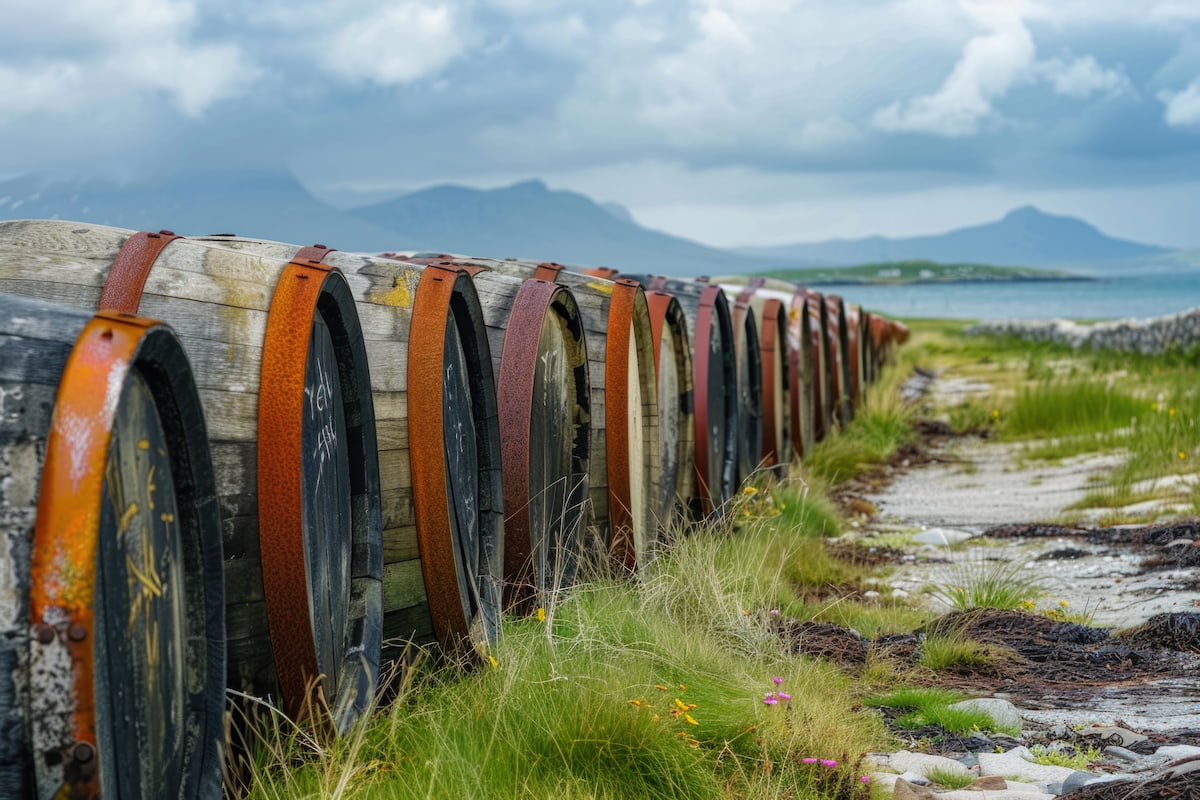You may have heard of a process with maturing whisky, affectionately known as the Angel’s Share. This evaporation is what creates such wonderful whisky, though it does mean we don’t know exactly what is left in the cask as it matures, unless we open it up and check.
Have you ever considered how we measure the ‘contents’ of a whisky cask? Trying to find the exact volume of liquid in a cask and what percentage of alcohol by volume is pretty straightforward when you know what you are doing, however there are a number of things that to be considerate of.
Firstly, What is a regauge?
It is essentially an MOT or health check of a cask and its contents, a way to measure what volume of liquid remains in a cask and at what strength it currently sits. There are several types of regauge, from a wet dip, to a full disgorge. We recommend that a regauge is performed from the age of 6 years and every two to three years after that.
We’ll explore the different methods available across the industry, the equipment used and the reasons why we don’t always get the results we might be expecting.
Part of the issue lies in the fact that for decades, whisky casks have been looked at as a bulk commodity by large scale producers. With the biggest distillers within the industry producing hundreds of thousands of casks a year and then locking them away in bonded warehouses for future stock. When these casks are treated as simply a small cog in a huge portfolio of maturing liquid, there isn’t too much thought given to how much spirit is still in an individual cask ten years down the line.
Wet Dip Regauge
From this environment the ‘dip’ or ‘wet’ regauge was born and is the most common for a relatively quick health check. This technique uses a ‘dipping stick’ which is akin to an old fashioned metre rule, with the measurements calibrated to the characteristic of a cask. The dipping stick is placed into the cask through the bung hole and must sit directly on the bottom of the cask. It also has a moveable gauge which is larger than the bung hole and must sit flush with the top of the bung hole in order to get the most accurate results.
Once the warehouse operator is happy that the dipping stick is sitting directly on the bottom of the cask, in the centre of the cask and not propped up by thick sediment or in some cases an old bung that fell into the cask over the years, then the measurements can be taken.
The user removes the dipping stick, which will show the level of the liquid (wet part of the stick vs the dry part) which we can call measurement ‘A’. There is another measurement ‘B’ which is taken from the moveable gauge flush with the top of the cask, minus an estimated thickness of the staves. Thickness of staves is something we will discuss a little bit later.
We then take these two measurements, dividing measurement ‘B’ by measurement ‘A’, this gives us a % which signifies how ‘full’ the cask is. This percentage is then used alongside a HMRC Excise cask ullage table to provide the ‘bulk litres’ of liquid in the cask.
Pros and Cons
The pros to this method are of course speed and access, here the warehousemen don’t typically need to remove the cask from the rack and can regauge many casks in a day. The cons to this method are the room for error. Not all casks are made equally so there is a larger tolerance for variation in the measurements. The Ullage charts are based on average sizes where a hogshead should be 250L for example, in practice we have seen 270L hogsheads and everything between so the diligence of the operator is paramount.
Disgorge Regauge
Now let’s look at another regauge method, a full disgorge regauge. In our opinion this is the most accurate way to establish how much liquid is left in the cask, given you are emptying the contents to ascertain the volume precisely, however there are some considerations. This method involves disgorging the liquid from the cask into an IBC (Intermediate bulk container). Before this is done the IBC is weighed on a scale and recorded, then the liquid is moved into the IBC and the new weight is recorded, giving us the weight of the liquid which can easily be converted into litres.
Why are there considerations with this method? Firstly an IBC is an inert container which essentially stops any aging of the liquid and secondly, plastic is not the ideal material to store our delicious whisky in for the long term. With these two things in mind, we suggest that the liquid is quickly bottled or moved back into the cask before the wooden staves dry out and leads to excessive liquid seeping into the newly dried staves, a process called ‘in-drink’ which in turn reduces the amount of liquid available at the time of bottling and in some cases a larger reduction in ABV than you would expect or account for.
Pros and Cons
There is of course the obvious pro of this method being substantially more accurate, knowing exactly how much whisky you have in your cask is very important when it comes to planning for bottling and even more so if the whisky is incredibly valuable, where every drop counts. The cons to this method are the logistical undertaking, the cask will need to removed from its rack and then emptied, this level of disturbance for a wooden cask is best kept to a minimum given it can disturb the maturation and sometimes increase maturation losses. It is also more costly and slower to perform given the extra steps required.
A key consideration with both methods of regauging is the temperature of the warehouse and the liquid itself, the reason being is that the temperature of a liquid can affect its density. For example, a litre of water at boiling point weighs less than a litre of water at room temperature. In the world of whisky in Scotland we can have very low temperatures during winter, and in this scenario the liquid would weigh more than at a higher ‘room’ temperature, which also means there would be more liquid.
ABV: How Much Liquid is Alcohol
Now that we have the bulk liters as accurately as the above methods allow, we need to find out the ABV (alcohol by volume) of the liquid.
The vast majority of Scotland's warehouses use a piece of equipment called an Anton Parr Alcohol Meter which can accurately measure the ABV of the liquid, as well as the density and temperature of the liquid to make it even more accurate. It then uses a calculation to work out the ABV at a preset temperature which is usually in the region of 20-22 degrees celsius, which is what most bottling halls choose when bottling whisky. In some cases whisky is bottled at much lower temperatures if the bottling hall has not invested in a specialised space to bottle, which can cause discrepancies in the readings.
Whilst this piece of equipment is usually accurate to a couple of decimal places, it isn’t completely fool proof.
We recently experienced this variability, where we sampled the whisky 5 days in a row and received slightly varied results, even when temperature and density were taken into consideration. This we learned was likely caused by unusually high sugar content found in the liquid, this sugar content was due to the intensive sherry maturation in a very active cask over many years.
This scenario required the use of an alcolyzer, which is a very expensive but ultimately incredibly accurate piece of equipment. The alcolyzer results confirmed a more consistent ABV as the sugar content was not able to cause the same fluctuations. This piece of equipment is capable of handling and reporting on a number of different data points, including chemical compounds and the ABV down to several decimal points.
Once you have your ABV and your Bulk Litres you will have also learned your RLA or Regauged Litres of Alcohol - Which is the important number as all whisky casks are traded based on the alcohol content. You can use these numbers to ascertain how many bottles might be produced from the cask at that particular measurement.
RLA / ABV / Bottle Size = Bottle Count
For example 115.3 RLA / 0.534 / 0.7 = 308.45 bottles
Did You Know When Regauging
- Angels Share continues throughout the maturation of a cask
- Not all regauge methods are precise
- Variation in standard cask sizes can lead to further variability
- ABV% can fluctuate based on sugar content and temperature
- Regauges are an important part of cask ownership
- Disturbing a cask too often during maturation can cause increased losses
- There are different ways to measure the contents of a cask and each has its pros and cons
In conclusion, we should take the results of a regauge as a guide and not an exact science as there are a number of different things that can cause variation, unless the cask has been completely emptied in preparation for bottling. The important thing to note here is that operators in the warehouses may not know that something is off or incorrect as they will have completed the regauge in-line with HMRC policies and best practice.
We take a lot of care to analyse our regauge results and have a good ability to spot when something isn’t quite right, in turn allowing us to intervene and explore the results further. Ultimately our clients engage us to handle their liquid and bottling for them, so we must keep our client abreast of all of the developments, which we can all appreciate can be complex at times.
90% of the time a standard dip regauge and ABV recorded by the Anton Parr Alcohol Meter is absolutely adequate, though in some instances using full disgorge and specialist alcohol measuring equipment is required.
In the mystical world of bottling our treasured spirits, it is easy to overlook the level of detail that can be involved, so we hope that this short blog sheds some light on the process and expertise that is required to manage cask maturation and bottling of your spirits.
Bottling Guide
Download our comprehensive bottling guide to learn everything about the bottling process, from cask selection to packaging and final delivery.
Contact
Our Sales Expert
Reach out to our team for personalised advice and more information on our bespoke whisky services. We’ll help tailor the perfect experience for you.


.jpg)


